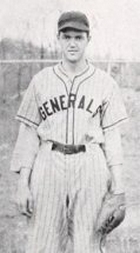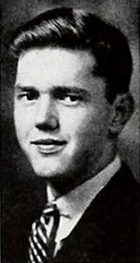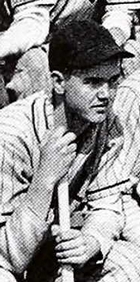Bob Gary
| Date and Place of Birth: | November 8, 1920 Beaumont, TX |
| Date and Place of Death: | February 4, 1944 McNary, TX |
| Baseball Experience: | Minor League |
| Position: | Infield |
| Rank: | Second Lieutenant |
| Military Unit: | 330th Combat Crew Training Squadron USAAF |
| Area Served: | United States |
Bob Gary had only just embarked on a professional baseball career when military service beckoned. The young Texan would not get the opportunity to resume his dream.
Robert W. Gary, Jr., the son of Robert (a school teacher) and Uta Gary,
was born in Doucette, Texas, and grew up in Beaumont, Texas.He had never played baseball before enrolling at
Washington and Lee University in Lexington, Virginia. That did not stop
him from trying out for the varsity team and he discovered a natural
talent for the game. As the team’s shortstop and captain, Gary hit .318
his senior year and led coach Richard “Cap’n Dick” Smith's team in RBIs,
doubles and triples. He also excelled in football and captained the
varsity basketball team. Smith described Gary as one of the best
athletes produced in many years.
After graduating, Gary taught at Fishburne Military Academy in
Waynesboro, Virginia, and was playing for Newport News of the Southside
League during the summer of 1940, when he was signed by the Washington
Senators’ organization and began his professional career with the
Mayodan Senators of the Class D Bi-State League. His manager at Mayodan
was Taylor Sanford, who had been his manager in the Southside League,
and Gary fit right in to the Senators’ line up. Playing shortstop and
leading off, he batted .305 with five home runs and 17 RBIs in 35 games
and finished the year playing third base with the Charlotte Hornets of
the Class B Piedmont League, where he hit .222 in 52 games.
On April 30, 1942, Gary was called into military service and trained as
a bomber crew navigator. Stationed at Biggs Field, Texas, with the 330th
Combat Crew Training Squadron, he had been with the same crew for some
time and they became very close.
Gary and Second Lieutenants Crantz, Savitsky and McDowell — all married
men — shared a house with their wives in nearby El Paso while stationed
at Biggs Field. On February 4, 1944, their Consolidated B-24E Liberator,
piloted by Crantz with Gary as navigator, was on a routine flight when
it crashed 60 miles southeast of El Paso at the bombing range at McNary,
Texas. All six crew members were killed. One can only wonder at the
scene when the news reached the home shared by the wives of Robert Gary
and his crewmates.
Bob Gary is buried at Forest Lawn Memorial Park in Beaumont, Texas.
|
Year |
Team |
League |
Class |
G |
AB |
R |
H |
2B |
3B |
HR |
RBI |
AVG |
| 1941 |
Mayodan |
Bi-State | D | 35 | 141 | 34 | 43 | 4 | 3 | 5 | 17 | .305 |
| 1941 |
Charlotte |
Piedmont | B | 52 | 189 | 26 | 42 | 3 | 1 | 0 | 6 | .222 |
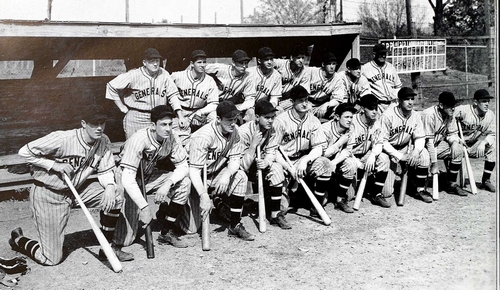
Bob Gary (front row, fourth from left) with the Washington and Lee University baseball team in 1941
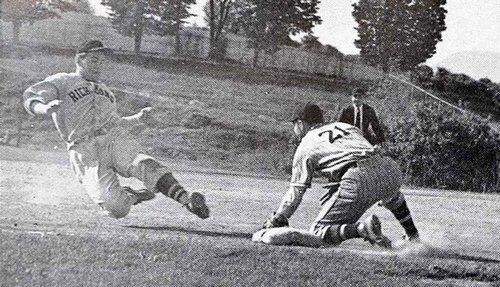
Bob Gary, ready to apply the tag on a Richmond runner in 1940
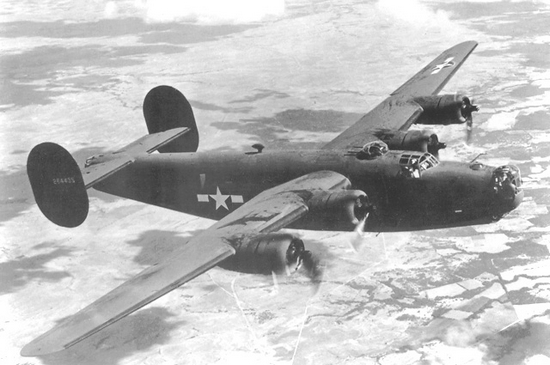
-
A B-24E Liberator. The type in which 2/Lt. Bob Gary was training to be a navigator.
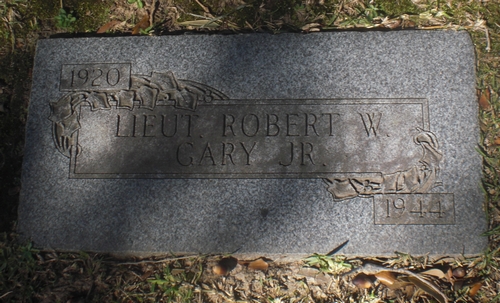
Bob Gary's grave at Forest Lawn Memorial Park in Beaumont, Texas
Thanks to the El Paso Public Library and Davis O Barker for help with this biography. Thanks to Mark Haubenstein for locating the above photo of Bob Gary (Source: 1940 "Calyx" Yearbook, Washington and Lee University Library). Thanks also to Astrid van Erp for help with photos and information for this biography
Date Added April 15, 2012 Updated August 2, 2017
Baseball's Greatest Sacrifice is associated with Baseball Almanac
Baseball's Greatest Sacrifice is proud to be sponsored by

